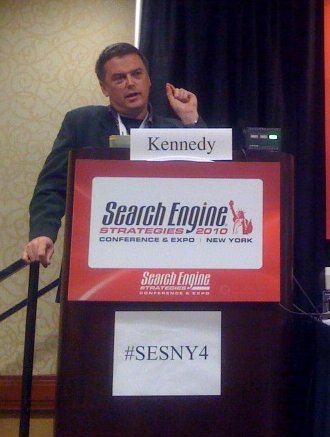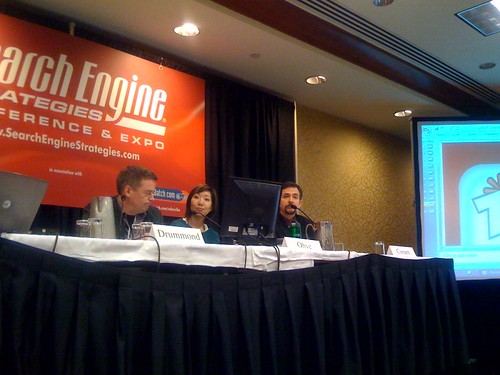From Real-Time Search to Dynamic Discovery
Moderator:
Anne Kennedy, SES Advisory Board, founder and MP, Beyond Ink, FP and CMO
Speakers:
Maile Ohye, Senior Developer Programs Engineer, Google
Mark Drummond, CEO, Wowd, Inc.
Larry Cornett, VP, Consumer Products, Yahoo! Search
Anne welcomes Maile to the podium. Maile says that she works with search and Webmaster Tools at Google, along with heading the Google Webmaster Tools blog.
She’s going to be talking about reach and relevance and understanding real-time search triggers.
Real-Time Search
With real-time results they’re looking to serve results that are relevant to popular topics right now that were posted right now. It has been launched in English, Russian and Japanese. It includes Facebook, Twitter, MySpace and Google Buzz.
Triggers for Real-Time Results
- Threshold queries are based on volume and delta
- Common queries for real-time results
Adjustments are according to user happiness metrics. If they suddenly see a lot of queries coming up about a certain celebrity getting a divorce, they’ll consider if real-time results are appropriate.
80 percent of their development of real-time search today is improving quality.
Quality signals are similar to general Web search:
- Link structure
- Followers and who you follow
- Linking to and from different places
- Semantic analysis of content (detects auto-generated information)
- Popularity of content (replies/retweets)
- Age of account
- Posting frequency
Looking Ahead for Real-Time Search
- They want to expand the depth of the real-time index (broader time searches, etc.)
- PubSubHubBub (PuSH) is an open platform for content providers, implemented by WordPress. This is expanding reach beyond just a few big players.
Relevance and the Social Graph
- Direct connections from Google Chat and Contacts
- Secondary connections
- Public markup (e.g. microformats) can describe relationships.
- <a rel=”me” href=”http://maileohye.com/”>
- <a rel=”friend” href=”http://www.mattcutts.com/blog/”>
By making identity open and indicating relevant connections, the networks will exist even if a site is down.
Reach and Relevance to TV
- Average American watches 5 hours a day
- 35 percent increase in Internet and TV together from Q3’09 to Q4’09
- 1/3 or Americans say TV ads are most helpful in making an online purchasing decision
Optimized for TV: http://youtube.com/xl
In TV ads they’re looking to apply the online ads expertise to the TV space. Advertisers can now load their online ads to TV, expanding the reach of ads. They want to avoid missteps they may have made when they tried their hand at radio ads:
- Fair market value based on an auction
- Pay only for impressions delivered. Charged only for impressions within 5 seconds of viewing.
Differences between online and TV space:
Online
- Intent-driven consumers
- Real-time ad auction
- Shown on individual basis
- Active users for click-through rate
TV
- Less clear whether ads fit viewers
- Ads are determined 24 hours prior
- Bulk viewing of ads
- Passive users for initial audience retained
Measure relevance: analytics integration
They wanted to make sure there’s a feedback loop that helps them recognizes if users are finding value in the ads. They’re hoping to create a sustainable ecosystem, and that requires that they’re accountable and allow advertisers to know what Google is doing for them and their ads.
 |
Next is Mark. He’s going to talk about what’s considered the real-time Web.
- The set of things that people are interested in, right now. The “attention frontier.”
- Not just Twitter, not just tweets
- Is crawling the way to create a Web-wide real-time index. He doesn’t think so!
He considers that old Michael Jackson music videos on YouTube were real-time content when Michael Jackson passed away because those videos were part of the Web that people were strongly interested in at the moment.
PuSH or other technologies are going to be very important to real-time search because a crawler looking at everything isn’t necessarily going to be able to see what’s trending.
Look into Twitter SEO to leverage sliding-window search opportunities.
The best real-time Web usability experience starts with discover and recommendation, but not search.
You can’t predict keyword and event association. If you were to look at a graph where interest in a real time event is one access and time is the other access. You’ll see a curve upward toward a spike. You have an advertising opportunity during that curve.
Larry is next and says that his presentation is based on a question he received earlier today. Sounds fresh! Yahoo! maintains two search engines, the one we usually talk about and Vespa, their real-time engine. They’re closing the gap between the two engines because people expect real-time results in their Web search.
What’s real-time search? It’s showing the most relevant and freshest content for a topic of recently increased interest. It’s not the freshest or the most relevant, it’s an intersection. Trending topics are now showing on the Yahoo! home page, and clicking on it lets people find out why it’s trending. This helps with the discovery that Mark talked about.
Real-time should fit into the context of what people are already searching for.
Challenges:
- Real-time indexing
- Find new content as it is published
- Crawl really fast and index news feeds, RSS, twitter
- Query analysis
- Discover queries we want to handle differently
- For most queries, promoting recent content degrades relevance
- Ranking for fresh content
- Adjust ranking algorithms
- Traditional ranking signals don’t show up
How do you know a query is really hot?
They discover real-time content through queries about emerging events and news stories (natural disasters, sports updates, political breaking stories, etc.). They’re also using language modeling to approach real-time result relevance. Language model = a way to explain a vocabulary to a computer
Real-time SEO best practices for marketers:
- Yahoo! targets real-time spam, so…
- Content must be related to the buzzing terms
- Don’t abuse URL shortening services
- Don’t overload with Twitter #hashtags

One Reply to “From Real-Time Search to Dynamic Discovery”
our real time search engine makes it simple for the user to navigate the real time web http://sency.com
we are excited about this niche
LEAVE A REPLY











